| Duration: | 01/2024 - 12/2026 |
| Contracting Authority/Sponsors: | Federal Ministry of Economic Affairs and Climate Action (BMWK) |
| Project Partners: | acp systems AG (Koordinator), Helmut Hechinger GmbH & Co. KG, Karlsruher Institut für Technologie/Helmholtz-Institut Ulm |
| Project Focus: |
VORAN – Innovative Sodium-Ion Battery Storage for Stationary and Mobile Applications


The manufacturing costs of batteries have recently been significantly reduced through the further development and scaling of processes and production. For many years, the focus of R&D has therefore been on the development of new materials with great potential for further cost reduction: on the one hand, the use of inexpensive and highly available starting materials can reduce active material costs. On the other hand, an increase in energy density leads to a further reduction in manufacturing costs in the material area and also has a cost-reducing effect on all non-material-dependent areas of manufacturing costs. Compared to sodium-ion technology, lithium-ion technology presents risks in terms of the availability of raw materials and price stability of the active materials.
In »VORAN«, the prerequisites for large-scale production of sodium-ion batteries (NIB) for stationary and mobile applications are to be created. Large-scale production is to be set up by the company Helmut Hechinger GmbH at the end of the project. The basis is an innovative technology platform that enables a lean production environment and is future-proof thanks to the flexible use of new cell chemistries. In this project, all components of the technology as well as the production technology for manufacturing the batteries will be developed along the entire value chain, including the recycling of the batteries.
The inherent disadvantage of NIB technology compared to LIB technology in terms of energy density is due to the approx. 0.3 V lower potential compared to lithium. However, this can be compensated for at the module level of the battery by various measures, which are being targeted in the project:
Shifting the active and passive material ratio towards the active materials: The higher mobility of sodium ions in the electrolyte compared to lithium ions should be used for this. This means that thicker electrodes can be used in the NIB system. The lower number of current collector substrates and separators directly results in an increase in energy density at cell level.
Use of a bipolar modular architecture: The production of identical and balanced individual cells is possible thanks to the high precision of material dosing during electrode production based on a dry coating process. The increase in energy density is achieved by eliminating the interconnection components and reducing the amount of material required to enclose the cells.
An existing technology platform for electrode production and modular architecture at Fraunhofer ISE serves as the basis for the development of the system. The focus of the active materials is on hard carbon with a capacity of > 300 mAh∙g-1 and preferably nickel-free and manganese-rich layered oxides as well as e.g. iron-containing transition metal phosphates.
The project consortium in the VORAN project fully represents this value chain: KIT/HIU and Fraunhofer ISE (material and process development); acp (mechanical and plant engineering, recycling); Hechinger (cell production). The partners in the VORAN consortium will also be responsible for setting up and operating large-scale production after the end of the project.